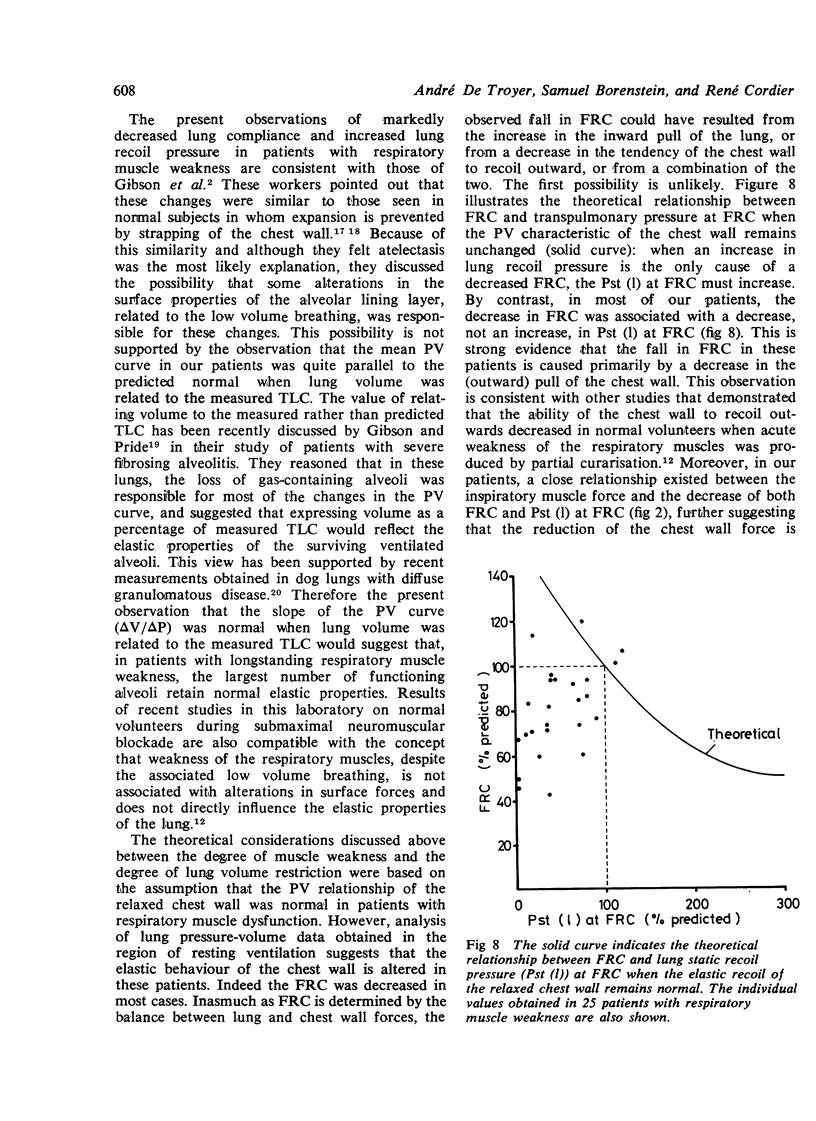Abstract
We investigated pulmonary mechanics in 25 patients, 9 to 55 years of age, with a variety of generalised neuromuscular diseases and variable degrees of respiratory muscle weakness. The average degree of inspiratory muscle force was 39.2% (range 8-83%) of predicted. The lung volume restriction far exceeded that expected for the degree of muscle weakness: the observed decrement in respiratory muscle force should, theoretically, decrease vital capacity to 78% of its control value, while the mean VC in our patients was only 50% of predicted. Analysis of lung pressure-volume curves indicated that the two principal causes of the disproportionate loss of lung volume were a reduction in lung distensibility probably caused by widespread microatelectasis, and a decrease in the outward pull of the chest wall. Because it reflects both direct (loss of distending pressure) and secondary (alterations in the elastic properties of the lungs and chest wall) effects of respiratory muscle weakness on lung function, we conclude that, in these patients, the vital capacity remains the most useful measurement to follow evolution of the disease process or response to treatment.
Full text
PDF







Selected References
These references are in PubMed. This may not be the complete list of references from this article.
- Amrein R., Keller R., Joos H., Herzog H. Valeurs théoriques nouvelles de l'exploration de la fonction ventilatoire du poumon. Bull Physiopathol Respir (Nancy) 1970 Apr-Jun;6(2):317–349. [PubMed] [Google Scholar]
- Braun N. M., Rochester D. F. Muscular weakness and respiratory failure. Am Rev Respir Dis. 1979 Feb;119(2 Pt 2):123–125. doi: 10.1164/arrd.1979.119.2P2.123. [DOI] [PubMed] [Google Scholar]
- De Troyer A., Bastenier-Geens J. Effects of neuromuscular blockade on respiratory mechanics in conscious man. J Appl Physiol Respir Environ Exerc Physiol. 1979 Dec;47(6):1162–1168. doi: 10.1152/jappl.1979.47.6.1162. [DOI] [PubMed] [Google Scholar]
- De Troyer A., Yernault J. C., Englert M., Baran D., Paiva M. Evolution of intrathoracic airway mechanics during lung growth. J Appl Physiol Respir Environ Exerc Physiol. 1978 Apr;44(4):521–527. doi: 10.1152/jappl.1978.44.4.521. [DOI] [PubMed] [Google Scholar]
- FAERBER I., LIEBERT P. B., SUSKIND M. Loss of functional residual capacity in poliomyelitis. J Appl Physiol. 1962 Mar;17:289–292. doi: 10.1152/jappl.1962.17.2.289. [DOI] [PubMed] [Google Scholar]
- Gibson G. J., Pride N. B., Davis J. N., Loh L. C. Pulmonary mechanics in patients with respiratory muscle weakness. Am Rev Respir Dis. 1977 Mar;115(3):389–395. doi: 10.1164/arrd.1977.115.3.389. [DOI] [PubMed] [Google Scholar]
- Gibson G. J., Pride N. B. Lung mechanics in diaphragmatic paralysis [proceedings]. Am Rev Respir Dis. 1979 Feb;119(2 Pt 2):119–120. doi: 10.1164/arrd.1979.119.2P2.119. [DOI] [PubMed] [Google Scholar]
- Gibson G. J., Pride N. B. Pulmonary mechanics in fibrosing alveolitis: the effects of lung shrinkage. Am Rev Respir Dis. 1977 Oct;116(4):637–647. doi: 10.1164/arrd.1977.116.4.637. [DOI] [PubMed] [Google Scholar]
- Hapke E. J., Meek J. C., Jacobs J. Pulmonary function in progressive muscular dystrophy. Chest. 1972 Jan;61(1):41–47. doi: 10.1378/chest.61.1.41. [DOI] [PubMed] [Google Scholar]
- Inkley S. R., Oldenburg F. C., Vignos P. J., Jr Pulmonary function in Duchenne muscular dystrophy related to stage of disease. Am J Med. 1974 Mar;56(3):297–306. doi: 10.1016/0002-9343(74)90611-1. [DOI] [PubMed] [Google Scholar]
- KILBURN K. H., EAGAN J. T., SIEKER H. O., HEYMAN A. Cardiopulmonary insufficiency i myotonic and progressive muscular dystrophy. N Engl J Med. 1959 Nov 26;261:1089–1096. doi: 10.1056/NEJM195911262612201. [DOI] [PubMed] [Google Scholar]
- Kreitzer S. M., Saunders N. A., Tyler H. R., Ingram R. H., Jr Respiratory muscle function in amyotrophic lateral sclerosis. Am Rev Respir Dis. 1978 Mar;117(3):437–447. doi: 10.1164/arrd.1978.117.3.437. [DOI] [PubMed] [Google Scholar]
- Lavietes M. H., Min B., Hagstrom J. W., Rochester D. F. Diffuse pulmonary granulomatous disease in the dog: relation between pressure-volume behavior and morphologic features. Am Rev Respir Dis. 1977 Nov;116(5):907–917. doi: 10.1164/arrd.1977.116.5.907. [DOI] [PubMed] [Google Scholar]
- Leith D. E., Mead J. Mechanisms determining residual volume of the lungs in normal subjects. J Appl Physiol. 1967 Aug;23(2):221–227. doi: 10.1152/jappl.1967.23.2.221. [DOI] [PubMed] [Google Scholar]
- Saunders N. A., Rigg J. R., Pengelly L. D., Campbell E. J. Effect of curare on maximum static PV relationships of the respiratory system. J Appl Physiol Respir Environ Exerc Physiol. 1978 Apr;44(4):589–595. doi: 10.1152/jappl.1978.44.4.589. [DOI] [PubMed] [Google Scholar]
- Stubbs S. E., Hyatt R. E. Effect of increased lung recoil pressure on maximal expiratory flow in normal subjects. J Appl Physiol. 1972 Mar;32(3):325–331. doi: 10.1152/jappl.1972.32.3.325. [DOI] [PubMed] [Google Scholar]
- Sybrecht G. W., Garrett L., Anthonisen N. R. Effect of chest strapping on regional lung function. J Appl Physiol. 1975 Nov;39(5):707–713. doi: 10.1152/jappl.1975.39.5.707. [DOI] [PubMed] [Google Scholar]
- VALLBONA C., SPENCER W. A. The total lung capacity and its subdivisions in respiratory poliomyelitis. J Chronic Dis. 1959 Jun;9(6):617–635. doi: 10.1016/0021-9681(59)90113-4. [DOI] [PubMed] [Google Scholar]
- de Troyer A., Yernault J. C. Inspiratory muscle force in normal subjects and patients with interstitial lung disease. Thorax. 1980 Feb;35(2):92–100. doi: 10.1136/thx.35.2.92. [DOI] [PMC free article] [PubMed] [Google Scholar]


